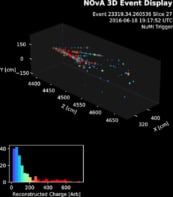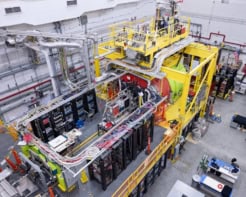Higgs bosons produced in conjunction with a pair of top quarks have been observed independently by physicists working on the CMS and ATLAS detectors at CERN. In both cases the statistical significance of the observations are well above the 5σ that is usually considered a discovery in particle physics. The results could open the door to a better understanding of the Higgs field, which gives fundamental particles such as electrons and quarks their unique masses.
In 2012, physicists working on the ATLAS and CMS detectors on CERN’s Large Hadron Collider (LHC) announced the discovery of the Higgs boson. First proposed in 1964, the particle and its associated field arise from a symmetry-breaking event that occurred in the very early universe. This created a uniform scalar field known as the Higgs field that pervades all space. Elementary particles such as leptons, quarks and the W and Z bosons “acquire” their distinct masses by coupling to this field.
Higgs particles are created at the LHC when protons are smashed into each other at energies as high as 13 TeV. There are many ways that a Higgs particle can be produced in a collision, including several processes that also create a top quark and a top antiquark. These processes are relatively rare, corresponding to about 1% of the Higgs particles created in LHC collisions.
Studying these processes is, however, of great interest to physicists because it provides an insight into how top quarks acquire their extremely high mass by coupling with the Higgs field. This, in turn could provide important clues about the microscopic mechanism that caused the Higgs field to emerge and fill space and time, which is poorly understood. The strong nature of the Higgs-top quark coupling also means it should be relatively straightforward to detect any possible deviations from the Standard Model, which could point to new physics.
Rapid decay
Physicists have so far obtained only limited evidence for the Higgs field coupling to the top quark, rather than making a full-blown discovery. The evidence has been both indirect and direct, with the latter requiring the identification of the Higgs particle and the top quarks produced in the collision. This is tricky, because all three particles decay far too rapidly to be detected themselves, meaning instead that their decay products have to be observed.
Writing in Physical Review Letters, physicists working on the CMS detector report the first discovery-level observation of the co-production of the Higgs particle and a top quark-antiquark pair. The observation involved sifting through huge amounts of data taken at proton-proton collision energies of 7, 8 and 13 TeV – looking for a number of different decay paths that can be taken by the top quarks and the Higgs. One route that was studied, for example, involves the Higgs boson decaying to a pair of bottom quarks whilst the top quarks decay to produce at least one electron or muon.
The CMS collaboration also calculates the Higgs-top quark coupling strength, finding it larger than that predicted by the Standard Model. However, this result has a relatively low statistical significance of about 1σ.
Higher production rate
Meanwhile, physicists working on the ATLAS experiment at the LHC have released a preprint of a paper that describes how they have also discovered Higgs production in conjunction with top-quark pairs. Again using data from 7, 8 and 13 TeV proton-proton collisions, the ATLAS analysis identified the production process at a statistical significance of 6.3σ. The ATLAS team also calculated the rate at which Higgs bosons are created along with a top-quark pair for 13 TeV collisions. While their value is slightly larger than that predicted by the Standard Model, it agrees within experimental uncertainty.

CERN discovers Higgs-like boson
“These measurements by the CMS and ATLAS Collaborations give a strong indication that the Higgs boson has a key role in the large value of the top quark mass”, says Karl Jakobs, spokesperson of the ATLAS collaboration.
Fabio Cerutti of ATLAS says that observing the Higgs -top quark production is “a very important result and a milestone in high-energy physics that was one of the main goals of run 2 of the LHC,” which began in 2015 and will end this year.



